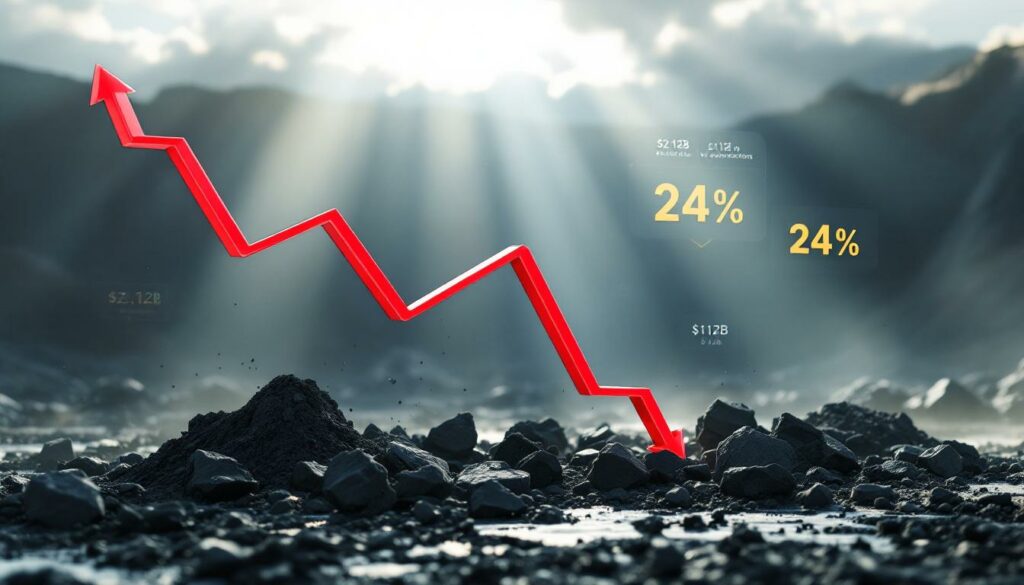Vale's Q2 Financial Performance: Understanding the 24% Profit Decline
Brazilian mining giant Vale has reported a significant 24% year-on-year decline in its second-quarter profits for 2025, with net earnings falling to $2.12 billion. Despite this substantial drop, the company managed to exceed analyst expectations, demonstrating resilience amid challenging market conditions. This comprehensive analysis examines the factors behind Vale's performance decline, market implications, and future outlook.
What Caused Vale's 24% Profit Drop in Q2?
The 24% profit decline reported by Vale represents a complex interplay of market forces, operational challenges, and global economic conditions affecting the mining sector. Despite the reduced profits compared to Q2 2024, Vale significantly outperformed analyst projections by approximately 47%, with actual earnings of $2.12 billion versus the $1.44 billion forecast by LSEG analysts.
Several key factors contributed to this profit decline:
- Iron ore price volatility: Fluctuating commodity prices created downward pressure on Vale's core revenue stream
- Production volume variations: Changes in output levels affected overall sales volume
- Market demand shifts: Evolving consumption patterns in key markets, particularly China
- Cost structure pressures: Rising operational expenses affecting profit margins
While the decline appears significant at first glance, the company's ability to exceed market expectations suggests effective management strategies and operational resilience.
Disclaimer: This analysis includes interpretations of limited financial data. Investors should consult Vale's complete quarterly report and seek professional financial advice before making investment decisions.
How Does Vale's Performance Reflect Iron Ore Market Conditions?
Vale's Q2 results serve as a barometer for broader iron ore market dynamics, highlighting industry-wide challenges facing major producers. The company's performance reflects the complex relationship between global supply, demand fluctuations, and price volatility in the iron ore sector.
Global Iron Ore Price Volatility
Iron ore price trends have experienced significant fluctuations throughout 2025, creating challenging conditions for producers. These price movements directly impact Vale's profitability as the company's revenue stream remains heavily dependent on iron ore exports. Market conditions reflect ongoing tension between:
- Supply-side pressures from Australian and Brazilian producers
- Demand uncertainty in China's steel sector
- Inventory management strategies among major consumers
- Freight rate variations affecting delivered costs
Production Challenges and Operational Performance
Vale's operational effectiveness remains crucial to offsetting market headwinds. The company has implemented various strategies to maintain production efficiency while managing costs:
- Optimization of mining operations to maximize yield
- Strategic production adjustments based on market demand
- Technological integration to improve operational efficiency
- Cost containment measures across the production chain
These operational strategies have likely contributed to Vale's ability to exceed analyst expectations despite the challenging market environment.
What Are the Regional Impacts on Vale's Operations?
As Brazil's largest mining company, Vale's operations are significantly influenced by domestic conditions while maintaining a global market presence. Regional factors create both opportunities and challenges for the company's operations.
Brazilian Mining Landscape
Vale's domestic operations face a complex regulatory environment that impacts operational costs and strategic planning. Key regional factors include:
- Regulatory compliance requirements: Environmental and safety regulations affecting operational procedures
- Infrastructure dependencies: Transportation networks and port facilities influencing export capabilities
- Labor market dynamics: Workforce availability and cost considerations
- Energy supply considerations: Power costs and reliability affecting operational expenses
The company continues to navigate these domestic challenges while maintaining its position as Brazil's mining flagship and a critical contributor to the national economy.
International Market Position
Vale's global market position remains strong despite increased competition and changing market dynamics. The company continues to serve diverse international markets while adapting to evolving customer requirements:
- Maintaining strategic relationships with key Asian customers
- Developing market opportunities beyond traditional export destinations
- Competing effectively with Australian producers for market share
- Adapting product specifications to meet changing customer requirements
Vale's international market strategy remains essential to its long-term success amid shifting global iron ore demand insights.
How Does Vale's Performance Compare to Industry Peers?
Contextualizing Vale's performance requires comparison with other major iron ore producers facing similar market conditions. While specific peer data for Q2 2025 is limited, the broader industry context provides important perspective.
Comparative Analysis with Major Competitors
Vale's performance relative to major competitors like Rio Tinto, BHP, and Fortescue Metals Group offers insights into company-specific versus industry-wide challenges:
| Metric | Vale | Industry Average* |
|---|---|---|
| Profit Margin | Varies by quarter | Typically 15-25% |
| Production Cost | Region-dependent | $30-45 per ton |
| Market Share | ~15-20% | Varies by region |
| Price Realization | Grade-dependent | Benchmark-linked |
*Industry averages fluctuate based on market conditions and reporting periods
Sector-Wide Trends Affecting Mining Companies
Several industry-wide trends are affecting all major iron ore producers:
- ESG performance requirements: Increasing pressure for sustainable operations
- Market consolidation dynamics: Changing competitive landscape
- Technology adoption rates: Digital transformation across mining operations
- Capital allocation strategies: Balancing shareholder returns with growth investments
Vale's response to these sector-wide trends will likely influence its competitive positioning and future performance.
What Are Vale's Strategic Responses to Market Challenges?
Vale's strategic initiatives demonstrate a proactive approach to addressing market challenges and positioning for future growth. These strategies focus on both immediate operational improvements and longer-term strategic positioning.
Diversification Initiatives
Recognizing the risks of over-reliance on iron ore, Vale continues to pursue diversification strategies:
- Expanding presence in copper & uranium investment opportunities
- Developing downstream processing capabilities
- Exploring opportunities in emerging materials markets
- Balancing portfolio exposure to reduce commodity-specific risks
These diversification efforts aim to create more stable revenue streams and reduce vulnerability to iron ore price volatility.
Operational Optimization Efforts
Vale's operational improvements focus on enhancing efficiency while maintaining production quality:
- Implementing advanced analytics for production optimization
- Deploying autonomous equipment to improve safety and efficiency
- Reducing energy consumption and carbon footprint
- Streamlining logistics and supply chain operations
These operational enhancements support both short-term profitability and long-term competitiveness.
What Do Vale's Results Signal for Investors?
Vale's Q2 performance provides important signals for investors regarding both immediate financial implications and longer-term investment considerations. While the profit decline raises concerns, the company's ability to exceed expectations suggests underlying strength.
Investment Implications
Investors should consider several key factors when interpreting Vale's results:
- Dividend sustainability: Impact of reduced profits on shareholder returns
- Capital allocation priorities: Balance between growth investments and returns
- Balance sheet strength: Debt levels and financial flexibility
- Valuation metrics: Price-to-earnings ratios and other relevant indicators
These considerations will influence investor sentiment and valuation adjustments following the earnings announcement according to Vale's official financial results.
Future Outlook Indicators
Several indicators provide insights into Vale's potential future performance:
- Project pipeline developments: Progress on major expansion initiatives
- Production guidance adjustments: Changes to output forecasts
- Cost projection trends: Expectations for future operational expenses
- Market positioning strategies: Approaches to evolving competitive dynamics
These forward-looking indicators help investors assess Vale's long-term prospects beyond quarterly fluctuations.
How Are Commodity Price Movements Affecting Vale's Business Model?
Commodity price movements represent a fundamental driver of Vale's financial performance, with specific impacts across various aspects of the business model. Understanding these price sensitivities provides context for interpreting current results and projecting future performance.
Iron Ore Price Sensitivity
As Vale's primary product, iron ore price movements directly impact profitability:
- Revenue impact: Each $1/ton price change affects annual revenue by hundreds of millions
- Margin sensitivity: Higher prices improve margins; lower prices compress them
- Quality premiums: Vale's higher-grade ores typically command premium pricing
- Contract structures: Mix of spot pricing and term arrangements affecting price realization
This price sensitivity underscores the importance of Vale's cost management initiatives in maintaining profitability across price cycles.
Impact of Other Commodity Prices
While iron ore dominates Vale's portfolio, other commodity prices also influence overall performance:
- Copper market dynamics: Growing importance as Vale expands copper production
- Nickel price movements: Affecting returns from Vale's nickel operations
- Currency exchange rates: Brazilian real versus US dollar affecting cost structures
- Energy price fluctuations: Impacting operational expenses across mining operations
This multi-commodity exposure provides some portfolio diversification while introducing additional price variables.
FAQs About Vale's Q2 2025 Financial Results
What factors contributed most significantly to Vale's profit decline?
The 24% year-on-year profit decline primarily reflects iron ore price fluctuations, production challenges, and changing market dynamics in key export destinations. While specific contribution percentages aren't disclosed, market analysts generally attribute the largest impact to price movements in Vale's core iron ore business.
How did Vale outperform analyst expectations despite the profit decline?
Vale exceeded analyst expectations through effective cost management, operational efficiency improvements, and potentially stronger performance in non-iron ore segments. The significant outperformance (47% above forecasts) suggests either conservative analyst projections or successful implementation of Vale's operational optimization initiatives.
What does Vale's performance indicate about the broader iron ore market?
The results suggest continued pressure on iron ore producers globally, with market volatility requiring strategic adaptations from major players. Vale's experience likely reflects industry-wide challenges, including demand uncertainty in China and competition from Australian producers, rather than company-specific issues.
How might Vale's results impact its investment in future projects?
While the profit decline might prompt caution, Vale's ability to exceed analyst expectations could support continued strategic investments, particularly in diversification efforts. Capital allocation decisions will likely balance shareholder returns with growth investments, with particular attention to projects that reduce dependence on iron ore and implement modern mine planning techniques.
What are the implications for Vale's shareholders?
Investors should monitor dividend sustainability and capital allocation priorities given the reduced profitability. The company's ability to outperform expectations may provide some reassurance, but the declining profit trend warrants attention. Long-term shareholders should evaluate Vale's strategic positioning beyond quarterly fluctuations.
Conclusion: Vale's Strategic Positioning Amid Market Challenges
Vale's Q2 2025 results demonstrate both challenges and resilience in a volatile market environment. While the 24% profit decline reflects significant headwinds, the company's ability to exceed analyst expectations by 47% suggests effective management strategies and operational strength. The financial performance underscores the complex interplay of market forces, operational decisions, and strategic initiatives that define Vale's current position.
As Vale navigates these challenges, its response will likely focus on three key areas: operational optimization to enhance efficiency, portfolio diversification to reduce iron ore dependence, and strategic market positioning to capitalize on evolving opportunities. Furthermore, understanding iron ore forecast insights will be crucial for the company's strategic planning.
For investors, Vale's performance offers important insights into both company-specific dynamics and broader industry trends. While short-term fluctuations warrant attention, Vale's long-term strategic positioning and operational execution will ultimately determine its success in an evolving global mining landscape.
Disclaimer: This analysis is based on available financial information and industry knowledge. All investment decisions should be made based on comprehensive research, including Vale's complete financial disclosures and professional financial advice.
Want to Stay Ahead of Major Mineral Discoveries?
Discover why significant mineral announcements can yield substantial returns by exploring Discovery Alert's dedicated discoveries page. Powered by the proprietary Discovery IQ model, our service provides real-time alerts on ASX mineral discoveries, giving you an immediate market advantage.




